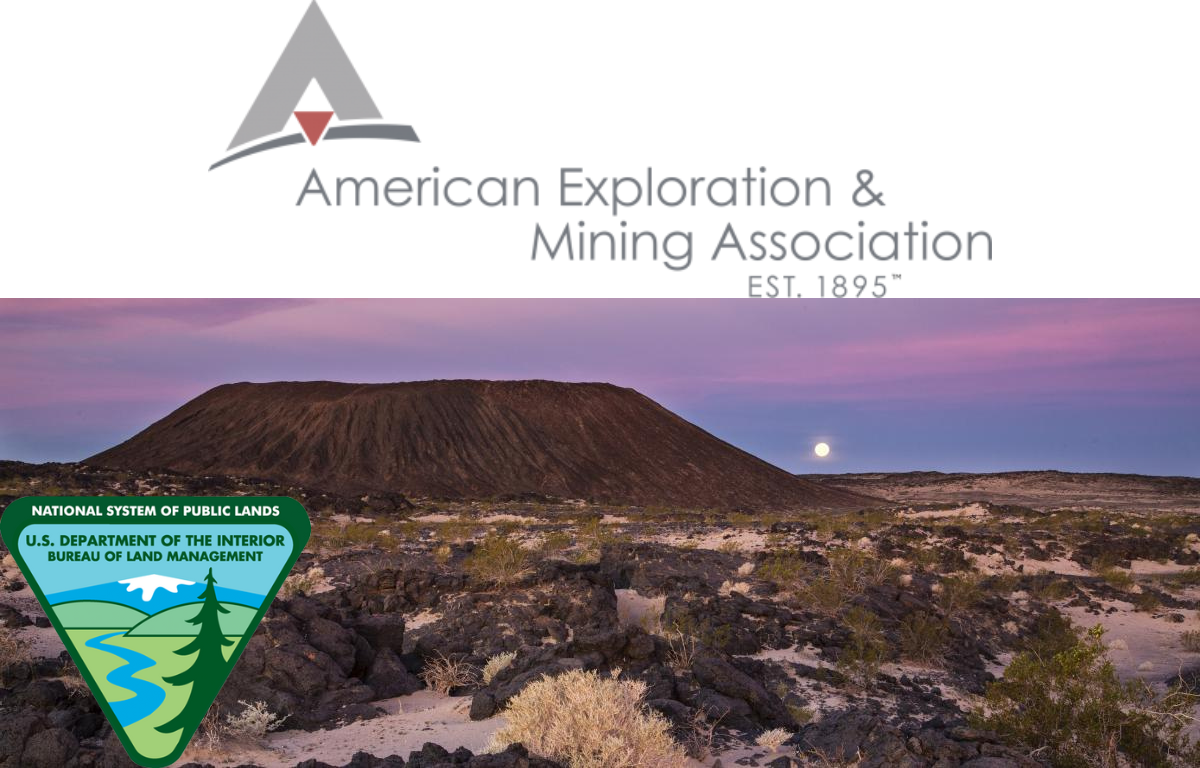This article was written by Mark Compton, Executive Director and Sid Smith Government Affairs Manager from American Exploration and Mining Association
After nearly 50 years of responding to the directives of the Federal Land Policy Management Act of 1976 (FLPMA) for administering public lands, BLM has had a revelation that adds conservation to the multiple uses enumerated in Section 102(a) of the statute.
The proposed rule focuses on three conservation measures: 1) an expanded use of the highly restrictive Area of Critical Environmental Concern (ACECs) designation; 2) creating conservation leases; and 3) preserving intact landscapes. These measures are fundamentally incompatible with many of the Section 102(a) multiple uses and will functionally withdraw millions of acres of public lands from mining, logging, ranching, renewable energy development, and other important uses.
The American Exploration & Mining Association’s (AEMA) concerns with BLM’s proposed rule include, but are not limited to:
The proposed rule violates the law. Despite BLM’s claims to the contrary, the “plain language” of FLPMA includes a list of “principal or major uses,” including mineral exploration or development, domestic livestock grazing, timber production, and a few others. The law specifies that its mandate “includes and is limited to” these uses. Notably, conservation or “nonuse” was not listed.
- If Congress intended for conservation to be a use “on equal footing,” they would have included it in the statutory list. BLM cannot change that. FLPMA Section 102(b) explicitly states: “The policies of this Act shall become effective only as specific statutory authority for their implementation is enacted by this Act or by subsequent legislation.” Creating conservation leases and elevating conservation to a major or principal use is a substantial change, not a “clarification,” as BLM asserts.
- BLM acknowledges the novelty of the conservation lease concept when it says “FLPMA’s declaration of policy and definitions of ‘multiple use’ and ‘sustained yield’ reveal [emphasis added] that conservation is a use on par with other uses under FLPMA.” The idea that this concept is just now being “revealed” 50 years after the passage of FLPMA is absurd and unlawful.
- The rule bears many similarities to the Planning Rule 2.0 for landscape-scale planning, which Congress repealed in 2017 through the Congressional Review Act. This proposal tries to repackage landscape-level planning as a tool to address climate change. This new justification for landscape-scale planning cannot be used to resurrect a concept that Congress has already rejected.
Conservation leases, ACECs, and preserving intact landscapes are de facto land withdrawals that undermine “multiple-use” standards outlined in FLPMA.
- The proposal would allow leases for conservation or compensatory mitigation. As worded, BLM could extend mitigation leases indefinitely, precluding the balance required under FLPMA.
- Future uses under the proposed rule must be consistent with the purpose of the conservation lease. In testimony before the House Natural Resources Committee on May 17, 2023, BLM Director Tracy Stone-Manning acknowledged that “energy development and mining would likely not be deemed compatible with a conservation lease…”
- As such, conservation would not just be “on equal footing,” it would be elevated above other uses.
Use of Areas of Critical Environmental Concern (ACECs) greatly expanded.
- Frequently abused to prevent development, the rule would allow ACECs to be larger and easier to designate. Area nominated must be managed as an ACEC until the planning process is completed.
- No consideration of impacts to multiple use or mineral resources within the nominated area is required.
- The rule will exacerbate permitting delays.
- Under the proposal, all lands will require a “Fundamentals of Land Health” review prior to authorization for use, a process currently applied only to grazing lands. BLM already struggles with large backlogs in grazing permit renewals because of this review requirement. Applying it to all uses would only serve to increase permitting backlogs for all productive uses.
Creates a New Zero-Impact Standard that Ignores How FLPMA’s Unnecessary and Undue Degradation Mandate Effectively Protects the Environment While Allowing Multiple Use.
- The rule’s unnecessary or undue degradation definition restates what BLM has implemented for nearly five decades to prevent excessive or disproportionate impacts.
- However, the new conservation measures demand zero impact in ACECs, conservation leases, and intact landscapes, which is contrary to FLPMA’s acknowledgement that some degradation is necessary for multiple use to occur and the requirement to minimize that degradation.
The rule ignores more than 50 years of Congressional intent and direction.
- The Mining and Minerals Policy Act of 1970 (MMPA); FLPMA (1976); National Materials and Minerals Research Policy Act of 1980 (MMPRDA); Infrastructure, Investment and Jobs Act (2021); and the Inflation Reduction Act (2022) all direct the Executive Branch agencies to respond to the Nation’s growing need for minerals. Instead, they are devising more ways to put land off-limits to exploration and development.
- This will likely exacerbate our dependence on foreign sources of minerals at a time when mineral demand is skyrocketing. The Biden administration’s own goals of fighting climate change and reducing carbon emissions require more domestic mining – not less. The rule fails to acknowledge any potential effects on our ability to develop minerals in the United States.
BLM’s rule is incomplete, deficient, flawed and rushed.
- The Regulatory Flexibility Act requires federal agencies to prepare a regulatory flexibility analysis, subject to notice and comment under the Administrative Procedure Act, if the rule would have a significant economic impact on a substantial number of small businesses and governments. BLM did not conduct a regulatory flexibility analysis prior to its arbitrary declaration that the rule “will not have a significant economic effect on a substantial number of small entities…”
- BLM asserts the proposal will have an annual effect on the economy of $100 million or less, so they did not conduct an economic analysis. However, the agency’s own “Sound Investment 2022” report shows multiple-use on BLM lands generated $201 billion in economic output last year. If conservation leasing decreases activity by just 1%, that’s an impact of $2 billion annually.
- The report mentioned above notes BLM redistributed $2 billion to States for revenue-sharing programs, yet BLM arbitrarily determined the proposed rule has no federalism implications, so it did not prepare a federalism summary statement of the effects on the States.
- BLM plans to use a Departmental Categorical Exclusion under NEPA, because the rule is “too broad, speculative or conjectural” to lend itself to “meaningful analysis.” This reasoning is flawed. The rule should be subject to an EIS containing an analysis of the significant socio-economic impacts, and the environmental effects of foregoing critical and strategic mineral development.
BLM should withdraw this rule.
The comment period for this new ruling closes July 5th, 2023. Please make your comment here: https://www.regulations.gov/document/BLM-2023-0001-0001
If you would like to read more about the ruling, you can do so here: https://www.blm.gov/public-lands-rule

